San Francisco’s Transamerica Building is the most iconic structure on the city’s skyline.
For this reason, it’s also a target.
It has a postcard-worthy significance comparable to New York’s Empire State Building or Chicago’s Willis (Sears) Tower. An attack on the towering pyramid would strike a particularly emotional chord in the Bay Area and get significant national attention.
That’s why it requires special attention on the part of law enforcement.
Urban Shield
SWAT teams were tested on exactly that at the Transamerica building during last weekend’s Urban Shield training exercise.
One after another, for 48 straight hours, 29 SWAT teams – including international teams from Israel, Jordan, and Bahrain – cycled through the building. Upon arrival, private security briefed them on the emergency:
Active shooter. 44th floor. Hostages.
Evaluators measured each and every decision from that point forward.
Officers David Maron and Jason Sawyer – both part of the San Francisco Police Department’s tactical unit – were the evaluators for half of the 48 hours.
Lightning fast, and correct
As soon as the teams were told of the active-shooter situation, they were expected to snap immediately into action. Ideally, one leader would step up and become the clear line of communication during the private security briefing.
“Some teams didn’t react quickly,” Maron said. “Others took off with no plan at all. You have to get up as quick as possible, but you want to get some kind of intelligence.
An active-shooter situation doesn’t absolve you of putting a plan together, according to Sawyer.
“You just have to do it while running to the target,” he said. “It’ll be a hasty, hasty plan.”
Some teams asked for floor plans and keys, which makes a case for reaching out to private security at iconic structures near you before an emergency arises. Every second counts; it would be nice to arrive at the scene with these tools already in hand.
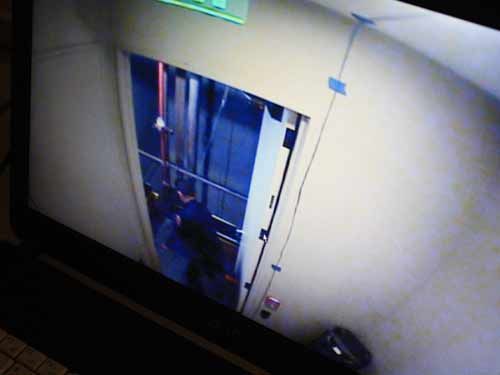 |
After the briefing, teams traveled up to the 48th floor with instructions to rappel down a smoke shaft to the 44th floor, where two hostage takers awaited. Compared to the moments that will follow, this portion unfolds slowly.
“It’s quiet at first,” one private security worker said. “But once they get in, they strike like a snake.”
It’s expected that the team has developed some kind of plan – likely a combination of prior training and whatever they scrapped together after the briefing – by the time they reach the room where the active shooter awaits. It’s not a matter of what plan the team implements; it’s purely a matter of how well they execute it.
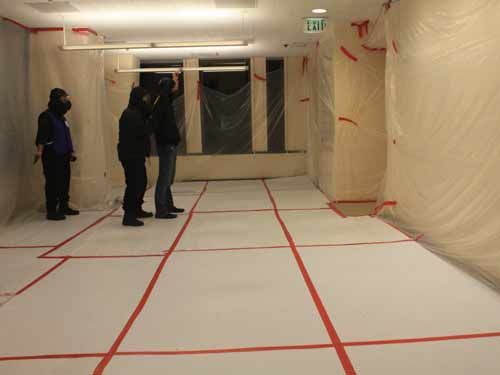 |
“You can’t sit back,” Maron said. “You’re going in blind, but your goal is to get to the shooter as quickly as possible. You have to understand that you might get shot, but it’s about saving people’s lives. Speed is key.”
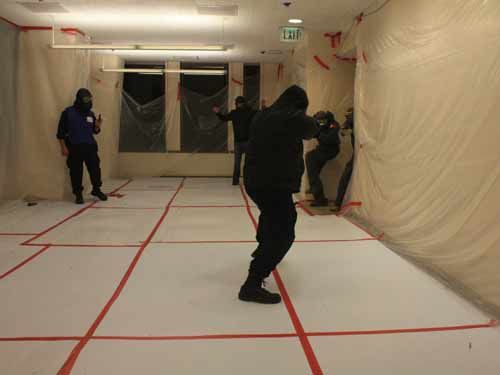 |
The first shooter peaks out at the end of a hallway and opens fire on the officers. With the lives of hostages hanging in the balance, each teams’ immediate reaction is vital.
Some charged immediately at that shooter, while others split up and implemented a hammer-and-anvil tactic.
“I’m not here to grade what tactic they use,” Sawyer said. “It’s about how they execute that tactic.”
After the initial attack, a second shooter appears from down a separate hall. Again, the team’s reaction is carefully watched by evaluators.
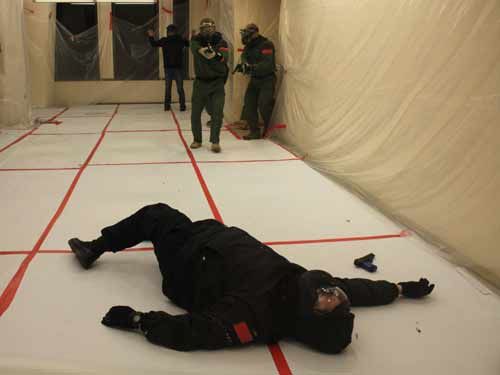 |
Once the room is clear and both shooters have (hopefully) been taken out, the team meets with the evaluators for a constructive debrief.
Debrief
“As evaluators,” Maron began. “You want to reward them for what they did, but also point out errors that could be improved.”
The teams that struggled most were the ones that hung back, firing down the hallway seemingly out of panic and surprise.
Sawyer says the fluidity and seamlessness of a team’s response depends heavily on regular training and muscle memory. The teams with few resources (part-time teams, mostly) will get more out of those 48 hours at Urban Shield than they will in weeks of department training. The lessons they learn will guide them as they move forward.
“These are very realistic scenarios,” he says. “Most are based on actual events. Whatever they do wrong in this scenario, they’ll take to the next site.”
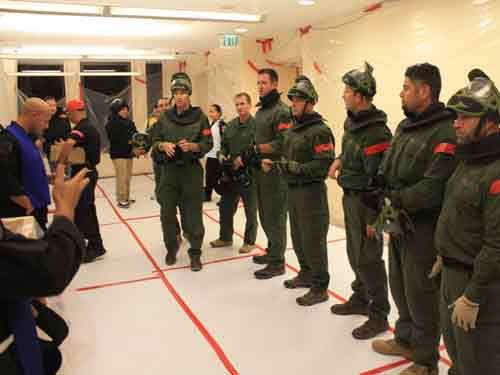 |
During the debrief, Sawyer complimented one team’s point man who pounced on the first shooter with particular speed.
“You probably took one right in the melon,” he said during the debrief. “But you were fearless, just like you have to be. You have to clear suspect number-one before taking your eye off.”
Maron said the best team to come through was the Israeli SWAT team.
“Their tactics were sound and they were the fastest.” He said of the eight-man team. “They split into teams of five and three. They cleared the room in 20 seconds.”
Sawyer told a story about two teams who completed the exercise on the same day: One cleared the room with only four bullets, two for each suspect.
“The other fired 64 rounds and hit nobody except me,” he said. “These are extreme examples of what you should and shouldn’t do. You had every shooter emptying their gun – like a panic shooting.”
The brilliance of Urban Shield, he says, is that it forces you to train for realistic scenarios under extreme circumstances (and no sleep for two days).
He was on the San Francisco Police Department’s team last year and says he was eager to watch how different agencies approached the same emergency.
“It was encouraging,” he said. “A lot of us are using similar principals and methodologies nationwide and in other countries.”
Although the focus of Urban Shield is on training, it’s also a competition.
This he says, is a huge motivator.
“I’m not going there to lose,” he said of his experience competing. “But a lot of it goes hand-in-hand. Israel didn’t know exactly what they were being graded on; they just showed their capabilities.”
And in the end, Israel won the competition.
Maron and Sawyer’s first 12-hour-shift as evaluators ended after they debriefed the Santa Clara team, which still had another 36 straight hours of similar scenarious to look forward to.
“I’m going to think about you when I’m sleeping tonight,” Sawyer told the team. “Right after I drink a beer.”



